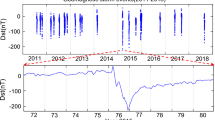Abstract
In this paper, the prediction model for ionospheric total electron content (TEC) based on Long Short-Term Memory (LSTM) deep learning network and its performance are discussed. The input parameters of the model are previous values of daily TEC, solar radio flux at 10.7 cm parameter of 81 day moving average (\(\overline{F107\_81}\)), sunspot number (SSN), geomagnetic Kp index, and disturbance storm time (Dst) index, and the outputs are TEC values for the target day. TEC data from January 1, 2001 to December 31, 2016 were used in this study. The dataset almost covers most of the years of the last two solar cycles (23, 24), and it is separated as 81.3% for training, 6.2% for validation, and 12.5% for testing. At BJFS IGS station (39.61° N, 115.89° E), LSTM yielded good TEC estimates with an RMSE of 4.07 TECU in 2001, it was 33% and 48% lower than the RMSE observed in TEC prediction using BP and IRI-2016 models, respectively. In the year of low solar activity (2016), the RMSE predicted by LSTM was 1.78 TECU, it provided 30% and 54% lower RMSE for TEC prediction than for BP and IRI-2016 models. Under the condition of magnetic storm, the LSTM TEC predictions are more consistent with the corresponding IGS Global Ionospheric Maps (GIMs) TEC than TEC predictions by BP and IRI-2016 models. LSTM can better grasp the influence of different external conditions on TEC. Seventeen grid points along 120° E meridian in latitude range from 80° S to 80° N were selected to further study the performance of LSTM model in different latitude. Results show that the prediction accuracy of LSTM is better than that of BP at different latitudes, especially at low latitudes. The performances of the two models are highly correlated with latitude and solar activity, and are both better than that of IRI-2016.


















Similar content being viewed by others
References
Altadill, D., Magdaleno, S., Torta, J.M., et al.: Adv. Space Res. 52, 1756 (2013)
Appleton, E.V.: Nature 691 (1946)
Atıcı, R., Aytas, A., Sagir, S.: Adv. Space Res. 65, 2158 (2020)
Bilitza, D.: Radio Sci. 36, 261 (2001)
Bilitza, D., Reinisch, B.W.: Adv. Space Res. 42, 599 (2008)
Bilitza, D., Watanabe, S., Truhlik, V., et al.: In: IRI-2016: Description and Introduction, 41st COSPAR Scientific Assembly, July, Istanbul, Turkey (2016)
Bilitza, D., Altadill, D., Truhlik, V., et al.: Space Weather 15, 418 (2017)
Chauhan, V., Singh, O.P.: Adv. Space Res. 46, 280 (2010)
Erdogan, H., Arslan, N.: Digit. Signal Process. 19, 740 (2009)
Gers, F.A., Schmidhuber, E.: IEEE Trans. Neural Netw. 12, 1333 (2001)
Gulyaeva, T.L.: Radio Sci. 34, 1507 (1999)
Huang, Z., Li, Q., Yuan, H.: Adv. Space Res. 55, 1775 (2015)
Ivanov, V.B., Gefan, G.D., Gorbachev, O.A.: J. Atmos. Sol.-Terr. Phys. 73, 1703 (2011)
Karevan, Z., Suykens, J.A.K.: Neural Netw. 125, 1 (2020)
Klobuchar, J.A.: IEEE Trans. Aerosp. Electron. Syst. 23, 325 (1987)
LeCun, Y., Bengio, Y., Hinton, G.: Nature 521, 436 (2015)
Li, S., Galas, R., Ewert, D., et al.: Acta Geophys. 64, 253 (2016)
Liu, L., Wan, W., Chen, Y.: Chin. Sci. Bull. 56, 1202 (2011)
Mallika, I.L., Ratnam, D.V., Ostuka, Y., et al.: IEEE J. Sel. Top. Appl. Earth Obs. Remote Sens. 12, 371 (2018)
Mallika, I.L., Ratnam, D.V., Raman, S., et al.: Acta Astronaut. 173, 221 (2020a)
Mallika, I.L., Ratnam, D.V., Raman, S., et al.: Astrophys. Space Sci. 365, 124 (2020b)
Nava, B., Coïsson, P., Amarante, G.M., et al.: Ann. Geophys. 48, 313 (2005)
Navares, R., Aznarte, J.L.: Ecol. Inform. 55, 101019 (2020)
Perrone, L., De Franceschi, G., Gulyaeva, T.L.: Phys. Chem. Earth 26, 331 (2001)
Sivavaraprasad, G., Deepika, V.S., SreenivasaRao, M., et al.: Geod. Geodyn. 11, 192 (2019)
Srivani, I., Prasad, G.S.V., Ratnam, D.V.: IEEE Geosci. Remote Sens. Lett. 16, 1180 (2019)
Stankov, S.M., Jakowski, N.: Acta Geod. Geophys. Hung. 41, 1 (2006)
Sun, W., Xu, L., Huang, X., et al.: In: 2017 International Conference on Machine Learning and Cybernetics (ICMLC) Ningbo, vol. 2, p. 340 (2017)
Tang, R., Zeng, F., Chen, Z., et al.: Atmosphere 11, 316 (2020)
Tebabal, A., Radicella, S.M., Nigussie, M., et al.: J. Atmos. Sol.-Terr. Phys. 172, 143 (2018)
Wrenn, G.L.: J. Geophys. Res. 92, 10125 (1987)
Wu, J., Wilkinson, P.J.: J. Atmos. Terr. Phys. 57, 1763 (1995)
Yan, S., Peng, Y., Guo, G.: Adv. Atmos. Sci. 12, 225 (1995)
Acknowledgements
The authors would like to thank the IGS for providing the research datasets and the NASA’s Goddard Space Flight Center for the space weather condition indices obtained using OMNIWeb interface.
Author information
Authors and Affiliations
Corresponding author
Additional information
Publisher’s Note
Springer Nature remains neutral with regard to jurisdictional claims in published maps and institutional affiliations.
Rights and permissions
About this article
Cite this article
Wen, Z., Li, S., Li, L. et al. Ionospheric TEC prediction using Long Short-Term Memory deep learning network. Astrophys Space Sci 366, 3 (2021). https://doi.org/10.1007/s10509-020-03907-1
Received:
Accepted:
Published:
DOI: https://doi.org/10.1007/s10509-020-03907-1




